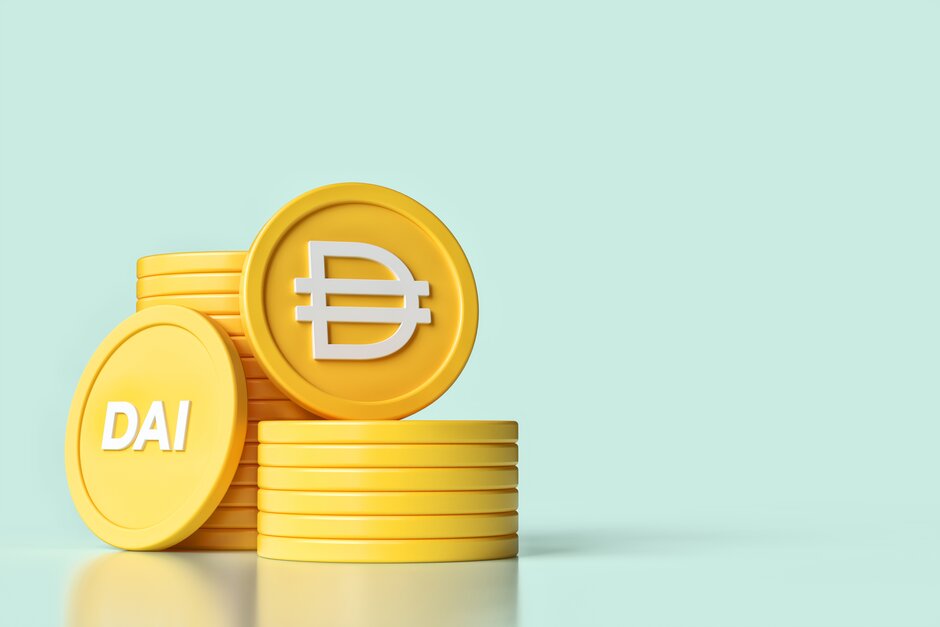In the world of cryptocurrencies, where extreme price fluctuations are the norm, the concept of a stablecoin has emerged as a potential solution to mitigate the risk of volatility. One of the most prominent stablecoins in the market is DAI. In this comprehensive article, we will discuss what DAI is, how it is generated, its role in the Decentralized Finance (DeFi) ecosystem, its potential benefits, and associated risks.
What is DAI?
DAI is a decentralized, cryptocurrency-backed stablecoin pegged to the U.S. dollar (USD). It was created by the MakerDAO project, which is governed by the Maker Protocol, a smart contract platform on the Ethereum blockchain. DAI was designed to maintain a stable value of $1 USD, making it an attractive option for those who want to reduce the impact of cryptocurrency price volatility.
How is DAI generated?
DAI is created through a process called Collateralized Debt Position (CDP). Users deposit an amount of Ether (ETH) or other supported cryptocurrencies into a CDP smart contract, which then generates DAI tokens based on a predetermined collateralization ratio. The collateralization ratio is the amount of collateral required for every DAI token issued. For instance, if the ratio is set at 150%, a user would need to deposit $150 worth of ETH to generate 100 DAI tokens.
The Role of MakerDAO and MKR Tokens
MakerDAO is the decentralized autonomous organization responsible for governing the Maker Protocol. It is a community-driven platform that uses a governance token called MKR to make decisions regarding the system’s parameters, including the stability fee, collateralization ratio, and the addition of new collateral types. MKR token holders have voting rights proportional to their holdings, allowing them to participate in the governance of the MakerDAO ecosystem.
DAI and the Decentralized Finance (DeFi) Ecosystem
DAI plays a crucial role in the DeFi ecosystem, serving as a stable asset for various applications. These include:
Lending and Borrowing Platforms: Users can lend or borrow DAI on platforms such as Compound, Aave, and dYdX. Lenders earn interest on their deposited DAI, while borrowers use DAI for various purposes, including leveraging their crypto assets or managing short-term cash flow needs.
Decentralized Exchanges (DEXs): DAI is widely used as a trading pair on DEXs like Uniswap and SushiSwap, providing liquidity for various cryptocurrency tokens.
Yield Farming: Users can deposit DAI into various liquidity pools or staking platforms to earn additional tokens or interest as a reward for providing liquidity or participating in a network’s consensus mechanism.
Payment Solutions: DAI can be used for everyday transactions, offering stability in comparison to other cryptocurrencies. Merchants can accept DAI as payment without worrying about sudden price fluctuations.
Benefits of DAI
Price Stability: DAI’s peg to the U.S. dollar makes it a stable store of value compared to other cryptocurrencies, allowing users to hedge against price volatility.
Decentralization: DAI is not controlled by a central authority or organization, ensuring that its value remains independent of external influences.
Transparency: The Maker Protocol and DAI’s underlying smart contracts are open-source and can be audited by anyone, fostering trust in the system.
Interoperability: As an ERC-20 token on the Ethereum network, DAI can be integrated into various decentralized applications (dApps) and interact with other tokens and platforms within the ecosystem.
Risks Associated with DAI
A. Collateral
Collateral Risks: While DAI is designed to be a stablecoin, it is still backed by cryptocurrencies like Ether (ETH), which are inherently volatile. If the value of the underlying collateral drops significantly, it could lead to the liquidation of CDPs, potentially destabilizing the DAI peg to the U.S. dollar.
Smart Contract Vulnerabilities: Since DAI is built on smart contracts, it is susceptible to potential vulnerabilities or bugs within the code. If a security flaw is discovered and exploited, it could compromise the integrity of the system and affect the value of DAI.
Regulatory Uncertainty: As with most cryptocurrencies, DAI faces potential regulatory challenges. Governments may introduce new regulations or restrictions that could impact the functionality or legality of DAI and the MakerDAO ecosystem.
Peg Maintenance: Maintaining the DAI peg to the U.S. dollar relies on a complex system of incentives and economic mechanisms. While the Maker Protocol has so far been successful in maintaining the peg, unforeseen market conditions or failures in the system could jeopardize its stability.
Oracle Risks: The Maker Protocol relies on oracles to provide accurate and up-to-date price data for the underlying collateral. If an oracle fails or provides incorrect information, it could have severe consequences for the stability and value of DAI.
Conclusion
DAI has emerged as a popular stablecoin in the cryptocurrency space, providing a decentralized and stable store of value that is particularly valuable in the DeFi ecosystem. Its design as an ERC-20 token on the Ethereum network allows for seamless integration with various dApps and platforms, making it a versatile asset in the world of digital finance.
However, users must be aware of the inherent risks associated with DAI, including collateral risks, smart contract vulnerabilities, regulatory uncertainty, peg maintenance, and oracle risks. By understanding these potential challenges, users can make informed decisions about whether to adopt DAI as part of their cryptocurrency portfolio or as a tool for navigating the DeFi landscape.






